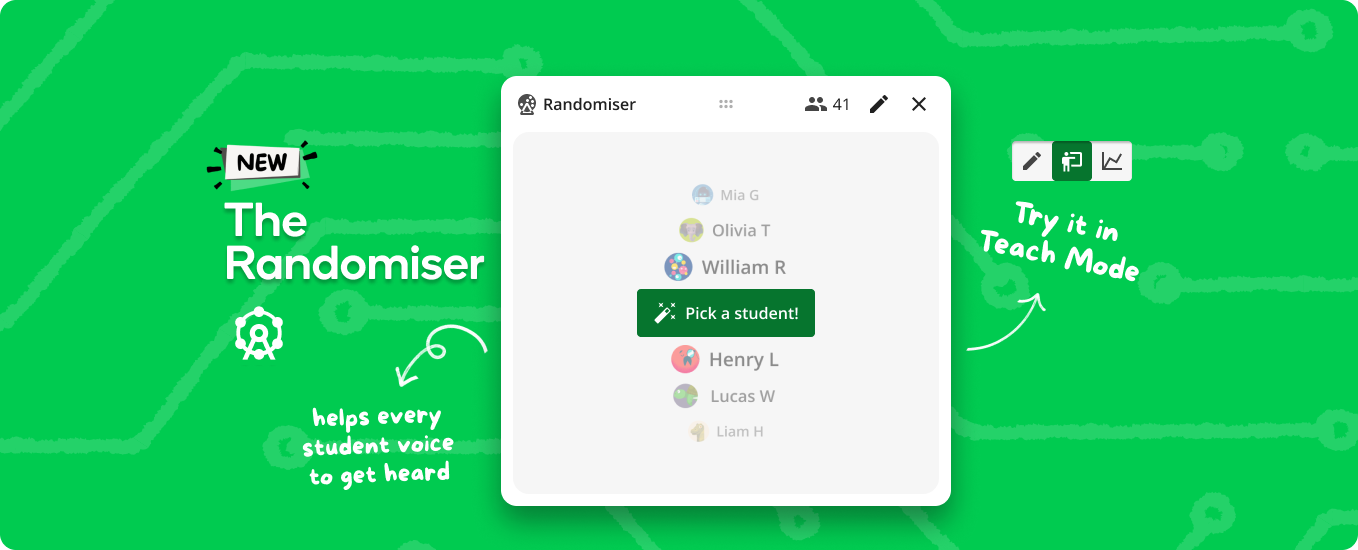Introducing the Randomiser: A simple way to get every student thinking

We’ve all been there.
You pose a question to your class — a good one, the kind that should spark lively discussion — and one, maybe two hands go up. If you’re lucky, three. And let’s be honest — they’re always the same three.
Or worse… silence. The kind that stretches just long enough for you to imagine tumbleweeds rolling across your lab benches.
It’s a familiar moment for every teacher. You’re eager to draw out your students’ thinking, to hear what’s happening in their heads, but the same confident voices fill the space while others quietly fade into the background.
That’s where Stile’s new Randomiser comes in.
With a single click, the Randomiser randomly selects a student’s name — gently inviting them into the conversation. It’s simple, fair, and just a little bit magical.
What makes it truly powerful, though, is what happens next. When it’s paired with one of the most effective (and often misunderstood) questioning strategies out there — cold calling — that quiet pause transforms into a moment where every student is thinking, engaged, and ready to share.
Why Cold Calling works
Cold Calling, a technique popularized by Doug Lemov in Teach Like a Champion (2010, 2021), flips the script on classroom participation – and it builds on a core principle from Dylan Wiliam’s work on formative assessment: “If we’re not collecting evidence from all students, we’re not really assessing learning — we’re assessing volunteering.”
Instead of asking “Who knows the answer?” and waiting for volunteers, you pose a question to the whole class, give everyone a moment to think, and then choose who will respond — whether their hand is up or not.
When done thoughtfully, cold calling creates active participation across your classroom. Every student is responsible for thinking. Everyone knows they could be called on. And that subtle shift changes everything.
But here’s the key: cold calling isn’t about putting students on the spot — it’s about making space for every voice, especially the quiet ones. And that’s exactly what Wiliam argues great formative assessment should do — make every student’s thinking visible, so teaching can respond in real time.
How to do it well
According to Lemov and decades of classroom research, effective cold calling means you:
- Pose the question to the entire class
- Pause and allow time for everyone to think
- Call on a student (and anyone could be chosen)
- Keep the tone warm, predictable, and supportive — not a test, not a trap
Of course, the tone and culture matter. As Wiliam reminds us, “It’s not about catching students out — it’s about catching their thinking.”
For example:
“Liam, what ideas came to mind for you?” “Amira, what were you thinking as we worked through that?” “Giovanni, what stood out to you, and why?”
These kinds of prompts shift the focus from getting it right to making thinking visible.
And that’s exactly where Stile’s Randomiser can help — it creates a visibly random, transparent selection process that feels fair to everyone in the room.
The Randomiser makes it easy
Stile’s Randomiser is designed to support teachers in making thinking non-optional — but in the kindest, most inclusive way possible.
With the Randomiser:
- A student is selected at random — making it clear that everyone is part of the conversation
- Students know they need to think, because they could be called on at any time
- Every voice gets a chance to be heard, not just the loudest ones
It’s a simple tool, but it has the power to transform classroom questioning.
Pair it with great pedagogy — and it becomes more than a name picker. It becomes a way to build a culture of thinking, trust, and belonging.
Make participation the norm, not the exception
The goal isn’t to catch students out — it’s to bring them in.
Stile’s Randomiser helps you do just that.
Give it a spin in your next lesson. Ask your question, wait… then let the Randomiser work its magic!
Want more ideas to boost participation in your science classroom? Explore our Stile Academy module on Boosting Classroom Participation — it unpacks this topic in even more depth. Check it out here.
More on the research…
Studies in both K–12 and higher education have shown that cold calling, when done thoughtfully, can make a big difference in how students think and participate:
- It boosts engagement and preparation.When students know anyone might be invited to share, they tune in more closely and come prepared to contribute.(Dallimore, Hertenstein & Platt, 2013)
- It balances classroom talk time. Cold calling helps balance classroom talk time, giving quieter or underrepresented students more opportunities to share their thinking.(Eddy, Brownell & Wenderoth, 2015)
- And what about anxiety? That part depends on how it’s done.Some studies show that when cold calling is part of a predictable, respectful routine, students actually grow more comfortable speaking up over time.(Dallimore, Hertenstein & Platt, 2013)
But others suggest that unpredictable or high-stakes cold calling can increase stress or fear of “getting it wrong” — especially if students don’t feel psychologically safe. Cooper, Downing & Brownell, 2018)
The key is the classroom culture. When cold calling is part of a routine and everyone expects it, it feels fair — even empowering.
Many educators now refer to this as “warm calling” or “equitable calling” to highlight its inclusive intent: every student deserves a chance to contribute. This approach also aligns with Dylan Williams ‘No hands up’ approach.
References
Dallimore, E. J., Hertenstein, J. H., & Platt, M. B. (2013). Impact of cold-calling on student voluntary participation. Journal on Excellence in College Teaching, 24(1), 85–102.
Eddy, S. L., Brownell, S. E., & Wenderoth, M. P. (2015). Gender gaps in achievement and participation in multiple introductory biology classrooms: Does active learning eliminate them? CBE—Life Sciences Education, 13(3), 478–492. https://doi.org/10.1187/cbe.13-10-0204
Wiliam, D. (2011). Embedded Formative Assessment. Bloomington, IN: Solution Tree Press.
